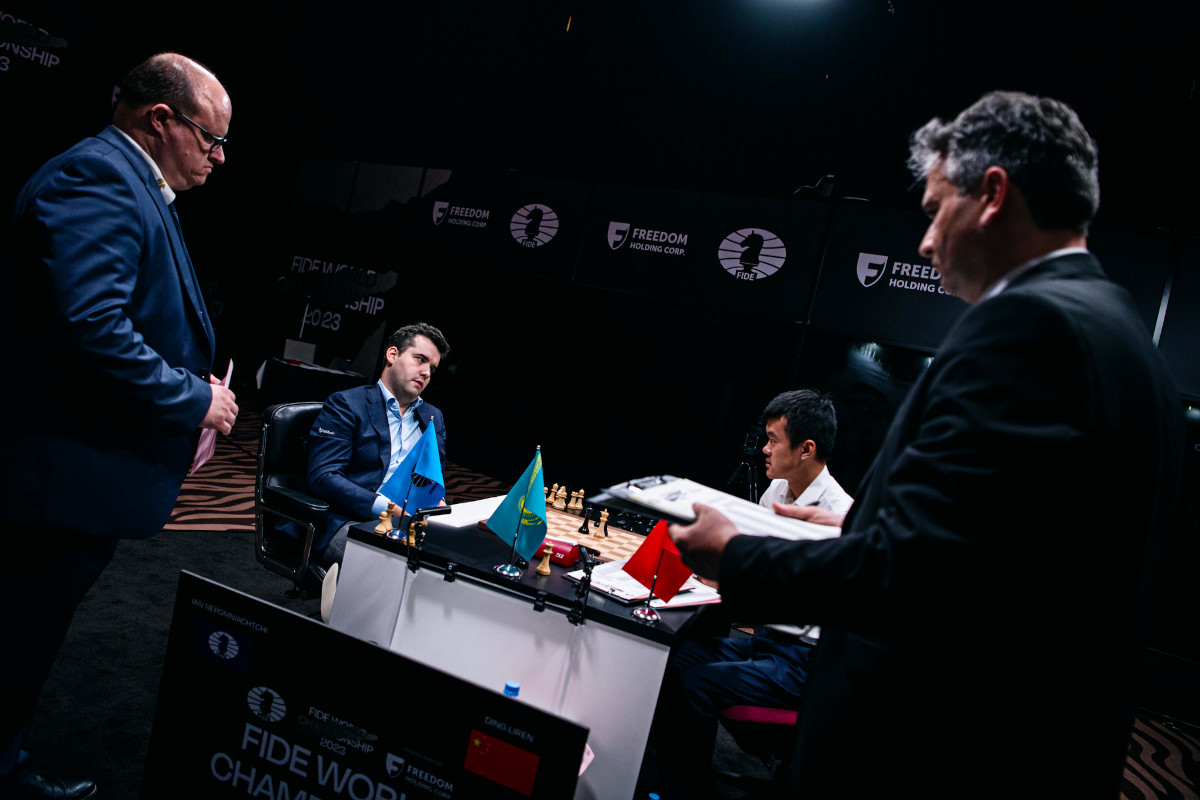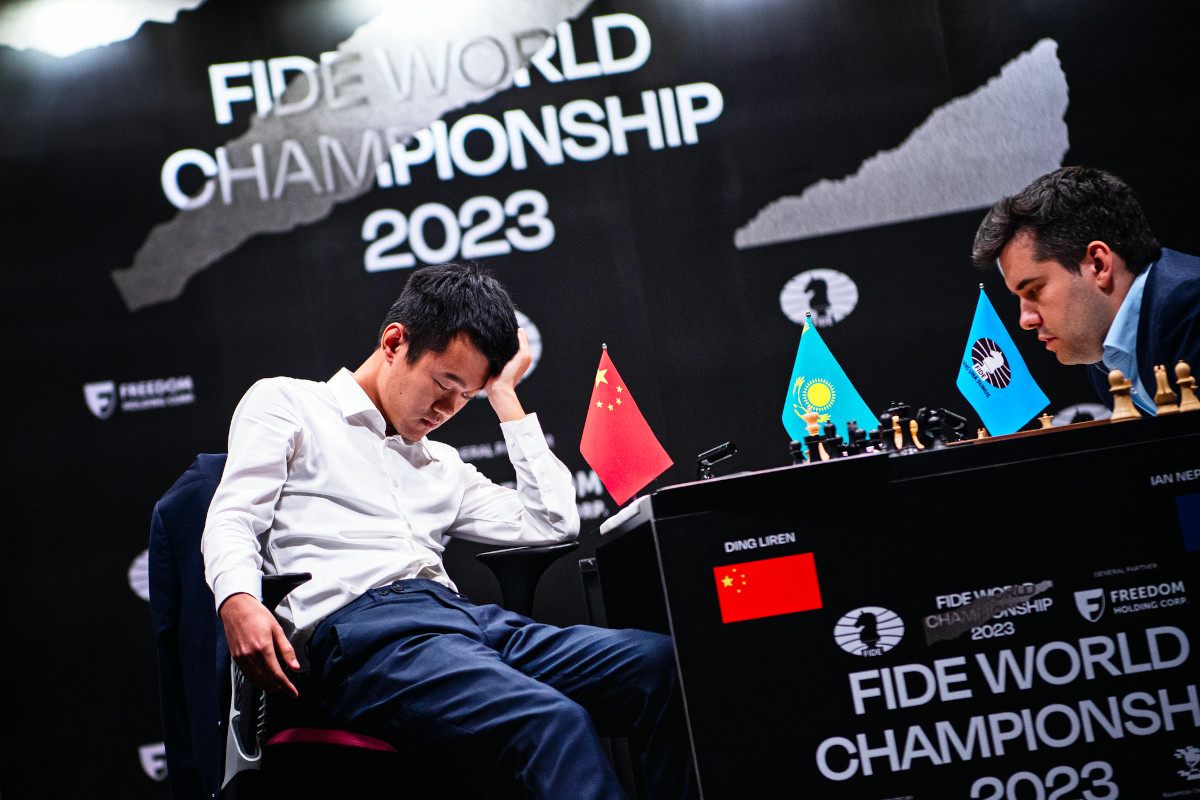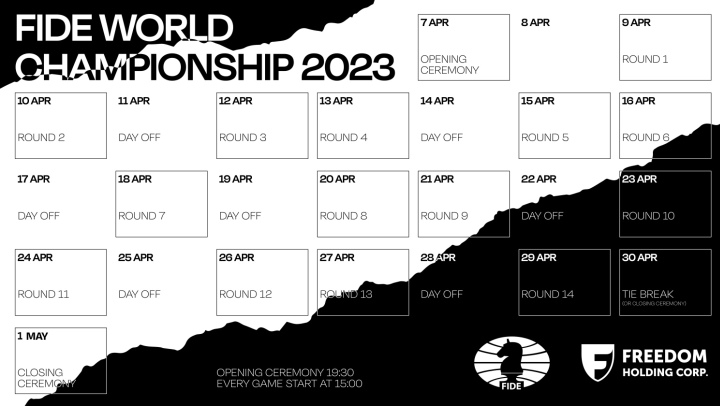.jpeg)

.jpeg)
Find expert commentary — video and game annotations — by well-known coach and author IM Robert Ris at the end of the article.
Much like Robert Ris in his video preview to game 14, many pundits have compared the final classical encounter between Ding Liren and Ian Nepomniachtchi with two previous instances of similar confrontations — i.e. the 2010 game facing Veselin Topalov against Vishy Anand, and the 2016 game facing Magnus Carlsen against Sergey Karjakin. These two games illustrated the most extreme approaches one can take in a final game with the score tied.
Topalov and Carlsen had the white pieces in these games. While Topalov regarded himself as the big underdog in a potential rapid playoff, Carlsen considered himself to be the clear favourite. Topalov went all-in and lost against Anand, while Carlsen implicitly offered Karjakin to take the match to a tiebreaker by entering a completely drawn variation — Karjakin agreed, and Carlsen went on to win the playoff in style.
But what would be Ding’s approach in Astana?
As it turned out, the Chinese grandmaster was closer to Topalov than to Carlsen. At some point during the game, it seemed like he would end up regretting his decision, much like Topalov, but imprecise play by Ian Nepomniachtchi in the endgame allowed him to escape with a draw...
...only after showing great defensive skills and strong nerves, though. In a game that lasted more than six hours and a half!

Game 14 is a draw | Photo: FIDE / Stev Bonhage
The match score is thus 7-7, which means a rapid playoff (followed by blitz games if necessary) will take place on Sunday. Since a rapid tiebreaker was implemented in World Championship contests, this is the fifth time that we will see a match (for the classical title) being decided in faster-paced time controls, as noted by chess.com’s Peter Doggers.
We will see the fifth tiebreak in world chess championship history after 2006 (Kramnik-Topalov), 2012 (Anand-Gelfand), 2016 (Carlsen-Karjakin), and 2018 (Carlsen-Caruana). I used to be strongly against rapid/blitz to decide a classical title but now only mildly!#NepoDing
— Peter Doggers (@peterdoggers) April 29, 2023
Now that the classical match is over, if we take a look at the results, we will note that 8 out of the 14 games finished drawn. Considering the amount of back-and-forth action, it is shocking that less than half of them were decisive. Jonathan Tisdall shared on Twitter:
Hard to believe over half the games were drawn. All I remember is a blur of violence.
As has been mentioned frequently, fatigue is playing a major role in the match, especially given how fighting the games have been. Additionally, the draws in games 13 and 14 were incredibly tense and there is no rest day before a 4-game rapid match in which players will need to adjust their strategies on the go.
It is no wonder that Anand stated right after game 14 had finished:
I feel exhausted just watching them!
We can only be grateful to the players for having offered such an entertaining performance. Now it all comes down to Sunday’s games, when Ding will get the white pieces in the first rapid encounter of the playoff*!
* Four rapid games with a time control of 25' + 10" will be played. In case of a tie, two sets of 5' + 3" games will follow. If the tie remains, single 3' + 2" games will follow (a single win will grant overall victory in this phase; play will continue until finding a winner).

Both players look exhausted in the post-game press conference — during the game, Ding Liren was uncharacteristically expressive | Photo: FIDE / Stev Bonhage
Out of a seemingly quiet Nimzo-Indian Defence, Ding showed his real intentions on move 12, when he played 12.Ng5 h6 13.h4.
Nepo later confessed that he “didn’t buy it” (meaning White’s attacking chances), since he had correctly developed his pieces in the opening.
Ding was already down on the clock by this point, and he went on to spend over 20 minutes on move 14. Perhaps noticing that he needed to apply drastic measures to avoid entering a passive, inferior position, he sacrificed a pawn in the ensuing middlegame.
21.Nc5 (instead of 21.Bf3) allowed 21...Bxg2, but it also gave White a couple of tempi to further activate his position with 22.Rg1 Bd5 23.e4 Bc6 24.b5
It was a case of White going for active defence at the cost of a pawn, or as stated by the legendary Boris Gulko and Mark Dvoretsky (the tweet was shared by long-time Carlsen’s second Peter Heine Nielsen):
To quote Dvoretsky and Gulko from one of Dvoretskys books:
— Peter Heine Nielsen (@PHChess) April 29, 2023
"This is one of the rare instances where you see someone play a strong tactical combination, resulting in the loss of a pawn."
Black had a superior position, with his extra pawn and better structure, in addition to Nepo’s advantage on the clock. Commentators considered that White seemed to have enough defensive resources, though — until Ding stuck to his guns with the active 30.Rcg3 instead of the more cautious (and correct) 30.Kd2.
Here Black needs to choose between 30...g6, dealing with the threat of Rxg7 and an immediate 30...Nxc5, which was played by Nepo.
It is true that it is not necessary to defend along the g-file, but the fact that Nepo only spent two minutes and a half before making this decision was questioned both by the commentators and by Keti Tsatsalashvili in the press conference. In hindsight, playing 30...g6 (which is also the engine’s top suggestion) might have given him Nepo the victory.
Ding was still in trouble, but yet another hasty decision by Nepo allowed him to survive.
Fabiano Caruana noted here that White is all but paralysed, while Black can safely attack the weakness on the b-file and create all kinds of threats against the vulnerable white monarch. Therefore, the simple 36...Rb3 was the best alternative. Nepo, however, spent less than two minutes before playing 36...e5, his biggest mistake in the game.
Ding, who was in mild time trouble, used a bit over ten minutes in the following 2-move sequence — and he found the correct continuation in 37.Rh8 Rd6 38.b6
A remarkable tactical idea justifies this pawn sacrifice: 38...Rxb6 39.Rxe8+ Kxe8 40.Bb5+, with a discovered attack along the third file. This was the idea behind b5-b6: to vacate b5 for the bishop to give the much-needed check!
White was still a pawn down, but defending the single-rook ending was certainly a simpler task. As it turned out, this specific setup was drawn for White.
Nepo did show great resourcefulness from this point on, as Ding needed to find precise plans to keep the balance. The draw was only agreed after 90 moves.
But ...e6-e5 had been the decisive mistake. Olimpiu Di Luppi clipped the momentous decision and shared it on Twitter, along with a brilliant remark by Caruana.
Arriving at the board, Ian Nepomniachtchi almost instantly played the weaker 36...e5, instead of 36...Rb3! "I think that Ian would have benefited a lot," Fabiano Caruana commented, "if someone were there during the game to tell him that this is a world championship game." pic.twitter.com/fxmv1VKKTS
— Olimpiu Di Luppi (@olimpiuurcan) April 29, 2023

| Advertising |